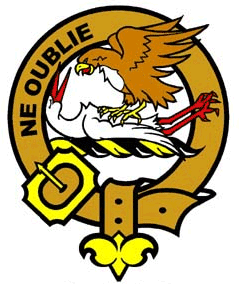Graham Clan
Graham Clan Crest: A falcon armed, killing a stork.
Graham Clan Motto: Ne Oublie (Do not forget).
Graham Clan History:
There is a legend that Gramus, a chief of Caledonia, was instrumental in demolishing the Roman Wall built by the Roman Emperor Antoninus between the Firth of Forth and the Firth of Clyde. However, William de Graham is the first recorded of the name in Scotland and was given lands in Midlothian by David I in the 12th century. In the 13th century, the family married into the earldom of Strathearn and acquired lands at Auchterarder in Perthshire. Sir Nicholas de Graham is recorded as attending the Scottish Parliament in 1290, an occasion upon which the marriage between Princess Margaret. Maid of Norway and Prince Edward of England was negotiated. Sir John de Graham, a supporter of Sir William Wallace, fell at the Battle of Falkirk in 1298.
In 1325, the Grahams were confirmed in the lordships of Kinnabar and Old Montrose. In 1370, they acquired the lands of Mugdock, north of Glasgow. Sir William Graham married Princess Mary Stewart, a younger daughter of Robert III, and, in 1451, their grandson Patrick was created Lord Graham. In 1504, Patrick's grandson was created 1st Earl of Montrose, but fell fighting for his king nine years later at the Battle of Flodden.
James, 5th Earl of Montrose (1612-50), elevated to become 1st Marquis of Montrose, was a staunch supporter of Charles I and Charles II against Oliver Cromwell's Commonwealth. A brilliant military leader, he was betrayed, captured and executed in Edinburgh in 1650. After the Restoration, his remains were honoured with a State Funeral. In 1707, his descendant James, 4th Marquis of Montrose, was created 1st Duke of Montrose in 1707.
Another prominent member of the family was John Graham of Claverhouse (1648-89), created Viscount Dundee (“Bonnie Dundee”). A persecutor of the Covenanters, he was a loyal Jacobite campaigner and died fighting at the Battle of Killiecrankie in 1689.
Thomas Graham of Balgowan (1748-1843) raised the 90th Regiment of Foot in 1793. He was Second-in- Command to the Duke of Wellington in the Peninsular War and was created Lord Lynedoch in 1814. James Gillespie Graham (1777-1855) was a prominent architect involved in the creation of Edinburgh's Georgian New Town. Kenneth Graham (1859-1932) was born in Edinburgh and wrote The Wind in the Willows.
Surname distribution in Scotland: The highest concentrations of the Graham name occur in The Outer Hebrides (the main islands include Lewis and Harris, North Uist, South Uist, Benbecula and Barra), Dumfries and Galloway (Dumfriesshire, Kirkcudbrightshire and Wigtownshire) and the Scottish Borders (comprising Berwickshire, Peeblesshire, Roxburghshire, Selkirkshire and part of Midlothian).
Places of Interest:
Mugdock, north of Milngavie, Glasgow. Acquired by David de Graham in 14th century.
St Giles Cathedral in Edinburgh. This is where the remains of the 1st Marquis of Montrose were interred.
Braco Castle, Perthshire. 17th century seat of the Grahams of Braco.
Kincardine Castle, Auchterarder, Perthshire. Seat of Graham earls of Strathearn, but passed to Grahams of Montrose. A new mansion house was built in the 19th century.
Killiecrankie, 3 miles south east of Blair Atholl in Perthshire. A Visitor Centre is run by the National Trust for Scotland.
Buchanan Castle, west of Drymen, Stirlingshire. Mansion built by the 4th Duke of Montrose
after the original house was destroyed by fire in 1852. In 1955 the roof was removed to avoid payment of death duties. It remains a ruin.
Brodick Castle, Isle of Arran. This came to the Montrose family through marriage to a daughter of the 12th Duke of Hamilton. Owned by the National Trust for Scotland.
Old Claverhouse Castle, Dundee. Birthplace of John Graham of Claverhouse, Viscount Dundee. The spot where the castle stood is marked with a dovecot.
Clan Graham membership prints.

